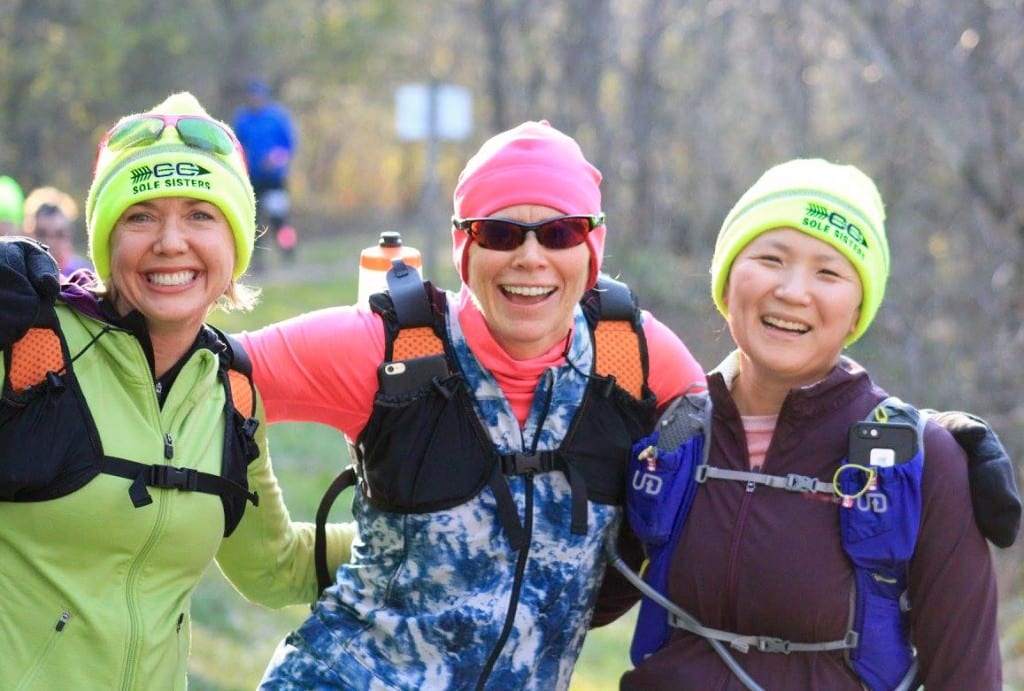Relieving Back Pain in Runners
You know your back pain is bad when…you ask your physical therapist, whom you’re seeing to rehab a fractured-in-four-places ankle, to help you with your back instead of your been-busted ankle.
A bit of background on my sore back: It started bothering me late last winter. The upper-left quadrant of my back felt clenched like a fist, around my shoulderblade. Then my left forearm and sometimes hand would get pins and needles. In my typical ignore-it-until-it-goes-away fashion, I, well, ignored it. The pain and tingling disappeared while I was laid up with my fractured ankle. (Silver lining!)

A really unflattering angle, but figured you’d need to see the shoulder opener (and, um, my husband’s “hope chest” where we store linens, next to soaker tub….)
The pain returned in September. No more tingling; instead I had a fair bit of pain in my forearm, especially near my elbow. My back pain was more severe, too, migrating up toward my lats and gripping much harder than before. The pain would flare up several times during the day, forcing me to stop typing and shake my arm out. The only time I was ever pain free was immediately upon waking, when it seemed as if my overly constricted muscles had (finally) relaxed overnight. I started taking prescription painkillers that had languished in our medicine cabinet during my ankle ordeal; I was extra-cranky toward my kids.
I thought the pain might be caused by my poor form during arm/shoulder work in barre class, so I switched to lighter weights. Then I blamed planks, so I modified that move in class, too. Perhaps it was running, so I consciously tried to relax my upper body during the miles. No improvement or pain abatement.
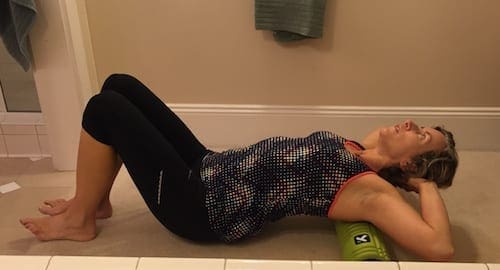
Hmmmm, looks like I still have *quite* a ways to go before I gain any real flexibility in my upper spine…but it sure feels 90% better.
Finally I mentioned it to my physical therapist, Ellen. Hearing the concern in her voice made me sit up and take notice: My head started to spin as she talked about pinched nerves, lasting repercussions, and other scare-me effects. Turns out I have really tight shoulders and very inflexible upper spine. (Not news to me, but they never caused me problems before.) Ellen suggested some very simple exercises with a foam roller that would help me open up those problem areas, hopefully alleviating the constriction.
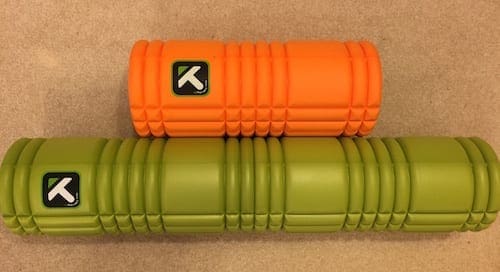
The green GRID 2.0 has been my morning mate lately; the orange GRID was my roller-of-choice when I was rehabbing my ankle.
Enter a TriggerPoint Therapy GRID 2.0. This 26″ long foam roller is my new BFF, and I eagerly greet it every morning. I set my alarm five minutes early to allow myself to do a few simple movements on it while I listen to the morning news. The first “move” involves no movement at all, simply laying on the floor with the roller positioned vertically under my spine. I rest my hands on the floor, and gravity works its magic, opening up my shoulder and chest.
Next I turn the GRID 2.0 horizontal under my shoulderblades. I try my best to curve my upper back toward the floor, supporting my head in my hands. The three-dimensional surface of the GRID 2.0 lets knobby bits of foam (uh, not a technical term!) apply additional pressure to tight muscles. I roll the GRID 2.0 up my back slightly, and curve toward the floor some more. Keeping my hands under my head and my elbows sticking out, I twist a bit to get the knobby bits pressing more into the side of my lats. I roll back and forth for at least one NPR story.
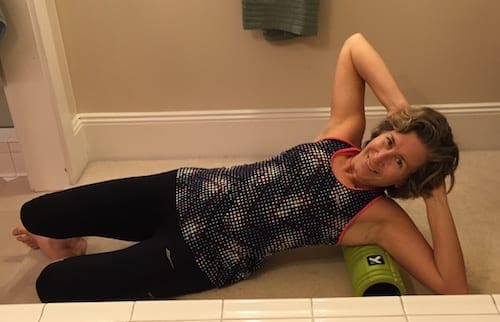
I usually roll in my PJs, but for figured an impromptu photo shoot called for Saucony Bullet Capri and Racer Back Tank.
The release I feel is immediate, partly due to increased blood flow. (The upper left quadrant of my back is flushed red after rolling.) And, after about two dedicated weeks of morning (and sometimes evening) rolling, my pain is almost gone. Even after a 2-hour bike ride on Saturday (hello, hunching!) and Sunday’s 7-miler, I didn’t experience any pain or tingling. While I’m now patting myself on the back for my daily roll-sessions, I’m also kicking myself for not taking rehab-matters into my own hands (and roller) sooner.
If you are in need of a foam roller (or any other pre/re-hab tools, like a STK or Massage Ball), feel the relief of a 20% discount at TriggerPoint Therapy’s website with code AMR20.
#AMRinSaucony: Don’t Take the Run for Granted
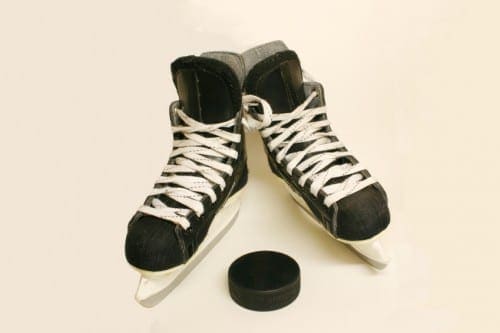
Forever skates. (And yes, these relate to being a mother runner.)
Amy Blake, our official #AMRinSaucony, has a tale of an ultra adventure–and the suprising body part that brought her down.
My husband Scott bought a new pair of hockey skates last week. It was a purchase he’s been contemplating for a while now—well over a year—and after a lot of research and trips to the local skate shop to try on different pairs, he settled on one, a.k.a., “The last pair of skates I’ll ever buy,” in his words.
Having a few months of being in the Masters running division under my belt, the transition to being 40+ has been mostly unremarkable. But I’ve been thinking about those skates, and how we’ve moved into a phase in our life when certain major purchases are now potentially the last we’ll ever buy. Because we’ll either get too old to use them or they’ll simply outlive us.
Makes you stop and think, right? And then weep quietly in your Metamucil?
But, back to running. Remember that ultra (Fall Back Blast) I was gearing up for last month? It’s been a week since the race. You know how when a memorable event occurs you flash back? For example, after my eldest was born, I’d think, oh, a week ago I was at the hospital and they’d just started the pitocin! Or, wow, I can’t believe that a month ago, at 7:45 Scott was cutting the umbilical cord. That kind of thing. This morning when the baby woke me up at 7am, I thought, last week at this time I was at my friend Karen’s house in her guest bedroom, turning off the alarm on my iPhone, popping a penicillin, and trying to decide if I was in any shape to run in the woods for a very long time.

One of these things doesn’t belong here. Hint: it’s not the mustard.
Spoiler alert: I didn’t finish the race.
Here’s the thing: Friday night, at a get together at Super BAMR Hostess Karen’s house with a group of BAMRs from WI and MN—many of them women I’d met at the AMR Run + Refresh Retreat last spring—I started to feel, as they say, “under the weather.” (Polite way of saying I felt like s***.) It started out with chills, so I threw on a hoodie. That didn’t help, and I noticed my left breast was unusually sore:
And it hit me: Mastitis.
And having enjoyed this oh so special sometimes side effect of breastfeeding two times prior with my son, I knew exactly what it was. (I’m still nursing Clara; she turns a year old next week!)
For those of you who’ve never had the pleasure of experiencing this, think flu on steroids. At least that’s how it has affected me. Mastitis is one of those things that could share a category with Voldesun – The Boob Thing That Must Not Be Named. Utter the word in conversation with women who’ve had it and no explanation needed; there is an instant shared sympathy.
The good thing about this particular situation (yes, there is actually a good part) is that I was staying with a Doctor Karen, so I got on antibiotics right away. Unfortunately, it wasn’t enough to get me to a place where finishing the race was a consideration.
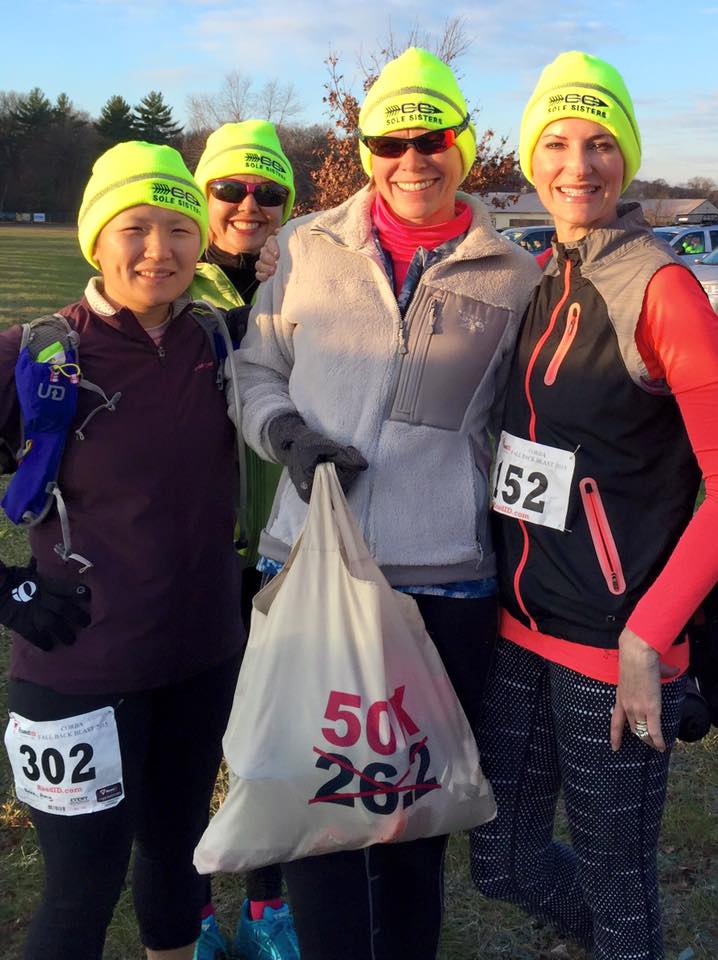
With BAMRs Anna, Karen, and Natalie at the starting line, my Ultimate Direction Ultra Vesta hydration pack filled to the brim with 2 liters of water. I was trying to be optimistic that I’d need it.
Well, it was briefly a consideration as the race day endorphins kicked in. I did make it to the starting line, making a deal with my body that I’d give one lap a shot (the course was four 12.5K laps on some sweet singletrack in Eau Claire, WI). That hope faded quickly – about two miles in. I knew there was no way I was making it for the entire distance. And after about 10K, I was just praying I’d make it to the finish of the first loop.
I’ve only had to drop out of a race once. When I tried to run Twin Cities Marathon in 2011 while 11 weeks pregnant with my son, I quit after 17.5 miles. I rode that yellow school bus to the finish line, grateful to be off my feet on what was the toughest race I felt I’d ever run. At the same time, I was devastated, feeling I was so close to the finish and second guessing myself. Could I have made it if I’d stuck it out just a little bit longer? (Okay, maybe having 8.5 miles left to go isn’t really “close.” Still, it hurt, even more than my pregnant body of softened ligaments.)
I can say with absolute certainty that I did not for a second think I made the wrong decision in giving up on my ultra goal. I’d given my best, and on that particular Saturday, it was 12.5K.

After finishing one 12.5K loop, right before Karen went off to run three more with Anna (Bad. Ass.) Still got my cow – I mean – bear bell. Yes, bears. Wisconsin has them.
The Fall Back Blast was supposed to be the pièce de résistance for 2015 – the last race of the year following baby #3 and a new distance. A new badge of honor to go along with turning 40: the title of ultramarathoner. But as the saying goes, timing is everything, and it was not my side for this race.
But the consolation prize was not so shabby. I got a much needed weekend away to myself, and even though I spent it completely miserable from a physical standpoint, I got some much needed rest and uninterrupted sleep without my three kids climbing all over me. (I love my kids, but the last thing you want to do when dealing with mastitis is deal with anything or anyone else!) I spent the weekend with some of my favorite people in the world and made some new friends. I felt pampered. Truly. Pampered and enveloped in BAMR love.

BAMR reunion!
This post was tough to write. No one likes to bomb out in a race, but the whole experience has given me a lot to think about. I had a really full year of running and races, more than I’ve ever attempted before. Two half marathons. Two 20 mile training runs (I’ve only made it through one of the 20 milers in any training plan in the past) and two full marathons, PRing in October. I am completely content with what I’ve achieved this year; it’s more than I ever imagined I’d be able to take on after having a baby.
The thing that hurts the most right now is that I’m hurt, physically. I’ve had some issues with my hip that have finally caught up with me to the point that I haven’t run since the Fall Back Blast. I’ve nursed it for a week, hoping it just needs a little rest. And maybe that’s why the sting of this DNF isn’t so acute. I’m putting all of my energy into not losing my mind on the longest hiatus from running I’ve had since April.
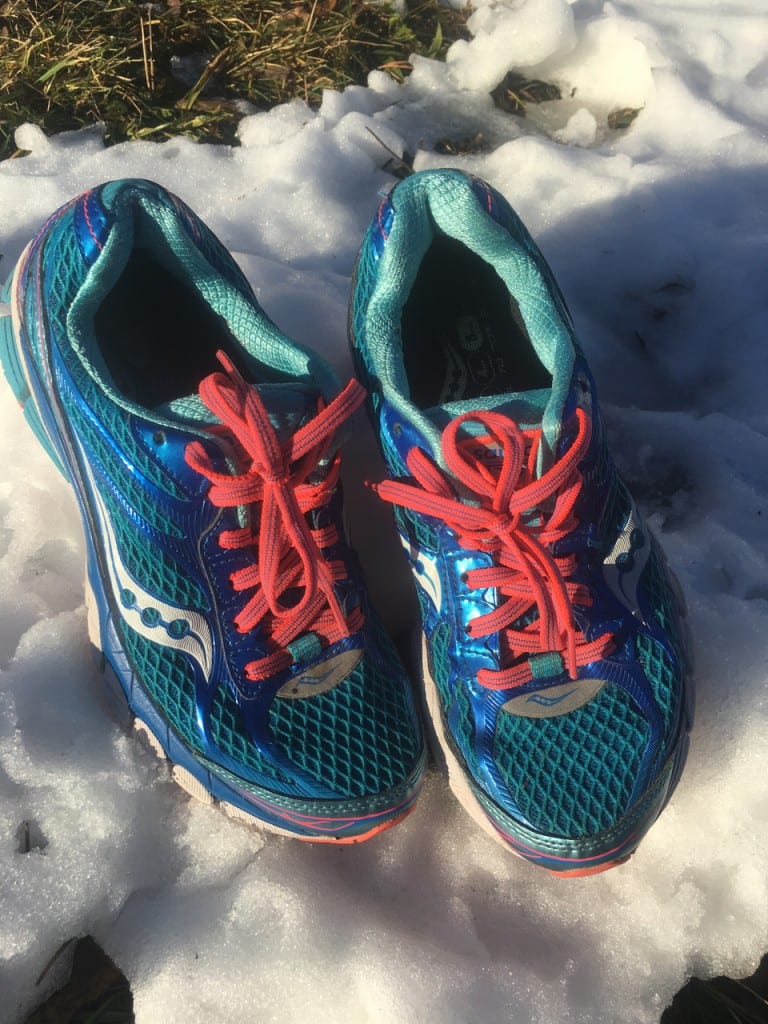
My Saucony Rides and yes, there is snow in my front yard. If you listen closely, you can hear them whimpering to be taken out to play.
And not to get all hippy dippy motivational poster-y on you, but this whole thing—not finishing the ultra, being temporarily on the DL (disabled list)—has me hearkening back to my preggo days, when the mere thought of running for a full city block sounded like the best. thing. ever. It’s so easy to take running for granted when you’re healthy.
Sitting on my butt this week has reminded me: don’t take the run for granted. And don’t let it take an injury to remind you of that.

Even when you don’t finish this race the way you intended, you still get just as much bacon as everyone else. Best post race food ever.
Back to that race. After some much needed sleep that afternoon, I made it back to the course to watch Karen and Anna finish the race. They gutted it out for just short of seven grueling hours on a challenging course.

Yes, she’s leaping after running for almost seven hours. How can this not make you smile?
Not finishing gave me the chance to do something else I don’t get to do very often: be a spectator and celebrate with them in their victory, which is the next best thing to crossing the finish line.
I’ll have ultra redemption; I’ve already got the date on my calendar marked for next year’s race. Freak sudden onset boob issues aside, I’ll show up more prepared and 12 months most post-partum than I am today, with the benefit of having a course preview.
And while it wasn’t the outcome I was hoping for, I’m okay with it. Really. Because I know that there will be other races. Unlike Scott’s new pair of hockey skates, this one won’t be my last.
Photo creds to the Chippewa Off Road Biking Association and the Fall Back Blast!
#186: Our Top Running Songs

Hard to tell whether Sarah’s jamming to Flo Rida or Eddie Vedder through the bluetooth wonder of Red Fox Wireless EDGE headphones
Dimity and Sarah consider this their “10K of favorite running songs,” as they both offer up their top six—with Dimity adding a .2 snippet. The mother runner duo intersperses snippets of their running songs, then reminisce about running (and sometimes rowing!) memories associated with the tunes. Find out why “Seasons of Love” from RENT soundtrack makes Dimity cry, and how Britney Spears powered Sarah up a series of epic hills. Dimity coins a few phrase, “lyric confidence,” while famed architect I.M. Pei even pops up in this lively conversation.
And here’s link to lip-synched “I Gotta Feeling” video, all one long shot, Sarah references. Some Spandex-clad runners even make a cameo about 2:40 into video. Good times!
*If you’re digging our podcasts, we’d be super-grateful if you’d take a minute (because we *know* you have so many to spare!) to write a review on iTunes. Many thanks.
**Also, the quickest way to get our podcasts is to subscribe to the show via iTunes. Clicking this link will automatically download the shows to your iTunes account. It doesn’t get any simpler than that.
Try This: Running Workout + Strength Workout (BOGO!)
We realize snow is starting to fall around the U.S., but this post, originally published two years ago, gives you ideas to mix up your runs–and honestly, make them much more fun.
Headed to Denver last month for one of our parties, I knew I wanted to try one of Dimity’s special runs-with-a-twist. No, it’s not an eye-opener of a cocktail with a curled strip of lemon peel. (Get it: a twist. Oh, I crack myself up.) Instead, it’s a workout that’s a run with strength and agility–and a good dose of fun–thrown in. Unlike some frou-frou mixed drinks, a run/strength combo workout has an easy-to-follow recipe: Round up some pals (or you can fly solo, if you’re okay with a few stares), appoint someone as a leader, decide on a four- to six-mile route, and set off.

Some knees drop lower than others during lunges. (Guilty as charged: That’s me in the capris and blue BAMR tank.)
Dimity recruited a bunch of her always-game neighborhood running pals, and Dim and I trotted to meet them at 5:45 a.m. Dimity filled the leader roll capably, telling us we’d be running five miles, stopping every mile to do a variety of four moves. And we were off. My glutes were just starting to feel warm-ish when we stopped at a dusty open space to do walking lunges, squats, dusty push-ups, and a core-quivering, minute-long plank. Up we popped, and we were off again, running another mile.
The next stop had us working on balance–one-legged pistol squats–and agility, with grapevine and another 1980s throwback fancy footwork drill. Then time to work the upper body with push-ups.
Another mile (including a turnaround at the halfway point) and it was time for four more moves, including burpees, which my knees (and quads!) didn’t love.
One final mile, then the final station of squats, tricep dips, push-ups, and more walking lunges because, come on, who doesn’t want an extra dose of quad-burn at the end of a run?
The whole workout took us a little over an hour, and it included far more laughs and group interaction than a regular 5-mile run. If you want to get in on the action yourself, round up some friends and head out. There are no hard-or-fast rules about which exercises to include or how often you throw in the moves. Just try to pay attention to various parts of the body, not just your lower half, which is already getting a workout from running. If you’re more of a time gal than a distance chick, stop every 10 minutes; if you want to bulk up the strength training, stop every five minutes or every half-mile. The choice is yours.
Tell us how you’ve mixed things up on a run. And if you’ve done a run like this one, with strength moves thrown in, which exercises have you found work best?
Your Baby, Your Running Coach: A Guest Post by Ro McGettigan

Hi, I’m Roisin (more commonly known as Ro). I’m an Olympian and co-author of the Believe Training Journal. More importantly, I’m the mother of two girls: Hope, 4, and Ava, 1-1/2.
When I was gearing up for the Olympics, it took over my whole life. Aspiring to be a world-class runner, I tinkered with nearly everything in order to maximize my performance: nutrition, sleep, extra-curricular activity, socializing, training, reading materials, you name it. Being a pro athlete isn’t something you do from 9-5. It encompasses your entire life. (If you think I’m exaggerating, just ask my husband!)
When I found out I was expecting my first baby, I anticipated that my athlete-lifestyle would be turned upside down. I assumed that since I wouldn’t be training as hard, and I wouldn’t be racing, that I would loosen the reins and enjoy the luxuries (lots of ice cream!) and the more lax lifestyle of the non-pro-athlete population.
Not so quick. As my belly grew, I soon realized that my “new normal” was in some weird ways more of the same lifestyle I’d be leading.
From the gate, I was advised to eat like an athlete: lots of iron, protein, greens, etc. and to avoid ice-cream (what??). I was supposed to plenty of rest and catch naps if I could. And, of course, the whole experience was a big buildup to (excuse the pun) the crowning event of the year. Instead of a major global championship, though, it was birth.
Those nine months were just the beginning of the similarities I was to discover between my two life experiences.
What I have found is that the life of a pro-athlete is is uncannily similar to the life of a little babe. Athletes (As) and Babies (Bs) have quite a bit in common—and Bs, to my surprise, are little gurus that we can all learn a thing or two from
Here are five of the most important things I learned from my baby about improving as an athlete. I hope that they’ll inspire you to improve too!
ONE: EAT LIKE A BABY
As and Bs are always hungry. When I was in serious training, I actually wondered if there was something wrong with me because I thought about food all day long. It’s only when I was around people not in training that I realized not everyone is ravenous at all times. Nobody wants to be around hungry athletes or babies waiting too long when eating out. Hanger is real! Needless to say I was well in tune with my baby’s need to eat every three hours.
As and Bs need to eat warm, nutritious, and easily absorbed food for their respective delicate and sensitive digestive system. I’ve heard of triathletes that eat baby food, and many of the top sports drink companies have attempted to create the same nutritional formula as breastmilk (check out the picture of my Muscle Milk tub!).
As a pro-athlete I was always trying to improve my recovery between workouts, and nutrition was a huge part of that. Milk (in whatever form suits you best) is best for As and Bs as it has the ideal carbohydrate, protein and fat ratios.
So if you’re ramping up your mileage for your first half/marathon and wondering how to fuel right, think like a baby and get your milk and easily absorbed foods in right after training. Something like a Picky Bar is ideal for babies and athletes alike!

Violet, the new daughter of three-time Olympian Kim Smith, a Kiwi.
TWO: SLEEP LIKE A BABY
A regular day in the life of a baby is as follows: sleep, eat, move (play/dance/crawl/climb), repeat. A day in the life of many top pro-athletes follows the same cycle.
A couple of hours of activity for my little one, and she is soon ready for her nap. Similarly, when I was at training camps with my sisters-in-sport in preparation for our race season, our routines were purposefully simple: sleep, eat, run, repeat!
When training at a high level, the recovery between training is just as important as the training itself. Sleep is where the muscles regenerate, and where recovery, growth and fitness gains are made. I’d need 10+ hours at night and a solid 90-minute nap during the day–a sleep schedule that very closely resembles my youngsters.
If you’re increasing your miles and feeling like you need more sleep than usual, catch it if you can. The rule of thumb is that you need an extra hour of sleep for every hour of training you do.
These days I don’t have the luxury of those mid-day naps, nor do I get near 10 hours of sleep, but I don’t need them as I no longer in training for any major races. But on those rare weekends when I get to join my pro-athlete friends, such as Molly Huddle, 17-time US Champ, and Kim Smith, for a longish run, you’ll find this weekend warrior crawling back into bed or snoozing on the couch for a nap.

I’ve.almost.got.it!
THREE: SET GOALS LIKE A BABY
When my baby was ready to crawl, the best incentive to get her moving was to put her favorite rattle on top of a stack of blocks, just out of reach. Her eyes would light up as she would zone in, determined. Then she would reach, stretch out and finally move towards her goal.
When setting goals for yourself, the first and most important criteria is that it must excite you. In order to work hard for something you must really desire the prize–whether it’s a rattle, a record or a medal.
When you really want a goal, you will endure whatever it takes to get there. I’ve seen my baby bump her head/face/bum so many times in order to pull herself up to the table so she can reach for the TV remote–her ultimate prize at one stage. Nothing fazes her when she’s in pursuit of getting her paws on what she really wants.
This reminds me of my years of running with tired legs, overused muscles, and my heart on my sleeve in order to achieve my goals. Logging more than 80 miles per week didn’t faze me when my desire was to be the best athlete I could be. But nowadays I wouldn’t even attempt it as it as my goals and desires have changed.
It’s important to note that if we put the remote too far away, my daughter wouldn’t even attempt to go after it. The goal had to be ever so slightly out of reach. So your goal must also be attainable, as unrealistic objectives aren’t motivating.
Before we knew it that little baby was onto her next milestone, and in what feels like a blink of an eye she is running all over the place. Once you’ve chosen your goal, break it down into doable steps. Once you start achieving and feeling successful, you’ll gain momentum, which will propel you to go after more and more goals.
FOUR: BOUNCE BACK LIKE A BABY
Athletes can mull over a miserable workout or a disappointing race for days, weeks, even months. Dwelling on the past not only takes up too much time and energy, it can deter us from trying again. Babies are free from their yet-to-develop egos that can cause us adults to over-analyze or self-criticize. Babies don’t think, “The last time I tried to walk I fell. Therefore I suck and should never try to walk again.” They fall on their butts again and again, often laughing along the way. Then they get back up and try again, usually with a smile still on their face.
If you don’t get your goal on the first attempt, so what? Stand up, and try again…and again…and again. Don’t quit at the first feeling of frustration. Frustration is a normal part of the process. See it as a litmus test of how badly you want to achieve your goal. Do your best, fall down, take a break, and then try again. You’ll get there.
Failure is not the opposite of success. It’s a stepping stone.

Olympic marathoner Paula Radcliffe, most definitely not a baby, knows the value of a good cry.
FIVE: SOOTHE LIKE A BABY
When babies have to endure unpleasant things–diaper changes, bumped heads, long car journeys–singing or playing a little game can be the distraction they need to get through the undesirable situations. Distractions take the focus off the pain signals and let you do your thing!
When you have to do uncomfortable things–a long run in freezing temperatures or a daunting workout–it’s helpful to ease the discomfort by running with friends or listening to music.
Everyone knows that when a baby hurts herself, she cries. The wails and tears communicate that she is hurt, and it triggers instinctual responses from others to help. By crying, the baby releases and rids her body of toxic stress hormones. And if you know babies, most times a little cry is followed immediately by smiles and resuming play.
So if crying is so therapeutic, why are adults so afraid to cry when we are hurting? Sometimes having a good cry is the best thing to help us deal with a big disappointment. Studies show that allowing ourselves to cry helps us get over the pain and feel better. So cry baby, cry! Then, move on. Even the world record holder in the marathon, the amazing legendary Paula Radcliffe is quoted in our Believe Journal talking about how crying helps her move on from disappointments:
“I’ve always been good at putting things behind me- I fall apart, do my crying big, and then put it away and move on”-Paula Radcliffe, marathon world record holder + world champion.
If one of the toughest athletes of all time isn’t afraid to have a cry now and again, why are the rest of us so afraid of crying?
Soothe the small; distract by focusing on fun. Grieve the big; cry and move on.
For 6 MORE ways your baby can be your running coach, hop on over to Ro’s blog!
How is your baby/toddler/child teaching you lessons that you can apply to running?
Roisin McGettigan-Dumas, is an Olympian, sports psychology coach and co-author of Believe Training Journal (VeloPress), now available in two new colors!
P.S. Interested in research on the topic of athletes and motherhood? Check out the research Ro’s invovled in at www.eliterunnerpregnancystudy.com
Three Great Places to Run in Portland, Oregon
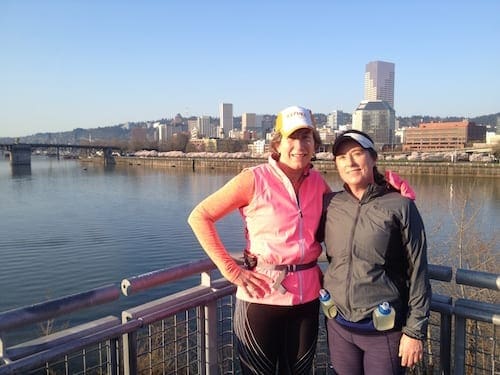
My BRF, Molly (right), and I taking a photo break before dropping down to the Eastbank Esplanade and Waterfront Park. Portland’s downtown, on the westside of the lovely Willamette River, lies behind us.
A few months ago, Dimity described her three favorite places to run in Denver, where she lives. Now it’s my turn: I’m serving up a trio of great places to run in Portland, Oregon.

Another pre-run photo op: This is Molly and me last Sunday morning at the NW Thurman gate to Leif Erikson Drive.
Leif Erikson Drive: Ignore the “drive” part in this options name: It’s an 11.2-mile long fire road closed to vehicles, nestled in the hills of the northwest quadrant of the city. It’s wide, relatively smooth packed dirt “road” that winds through Forest Park, one of the country’s largest urban forest reserves. Shaded by towering trees, like Douglas firs, red alders, and western hemlocks, with beautiful ferns and abundant moss covering the ground (and trees!), it stays cool in the summer and somewhat protected during Portland’s frequent “liquid sunshine” (read: rain). Numerous single-track trails branch off of Leif Erikson, allowing you to explore and make every run unique.

Two mother runners–Jen (left) and Maya–I met last week on Leif. (Each of them has four children!) Note the mile marker behind us: There are trailside markers every quarter-mile.
Waterfront Park: This is my go-to suggestion for folks staying downtown, as it’s almost literally a stone’s throw from many hotels. It’s a roughly 3-mile loop that hugs both the west and east side of the Willamette River, the waterway that bisects the Rose City. The paved route runs between the Steel Bridge on the north and the Hawthorne Bridge to the south (although you can easily add mileage by heading north on the west side or south on the east side). There are several water fountains along the route, frequented by numerous runners, walkers, and cyclists. (And, yes, homeless people: You’re likely to pass several camped out along the riverbanks or sleeping on benches.) Nifty note: Twelve-hundred feet of the Eastbank Esplanade section is a floating walkway, the longest of its kind in the U.S.
Terwilliger Parkway: Another popular running route with a misleading name, but break this one down into its parts: park + way. Terwilliger seems like a winding road with a very wide, well-lit sidewalk up a heavily wooded hillside, but it is actually a roughly 2.25-mile linear park designed by a landscape architect and intended for active enjoyment. Located a quarter-mile south of downtown, it’s another great destination for vacationers or business travelers. If your trip to Portland calls for a long run, you can wind your way from Waterfront Park, up Terwilliger, and on to Tryon Creek State Park—as long as you don’t mind some climbing. Heading south, Terwilliger is almost a continual climb. Not too steep, but it’s consistent. There’s a water fountain and restrooms about a third of the way up Terwilliger, and a water fountain awaits runners at the top.




